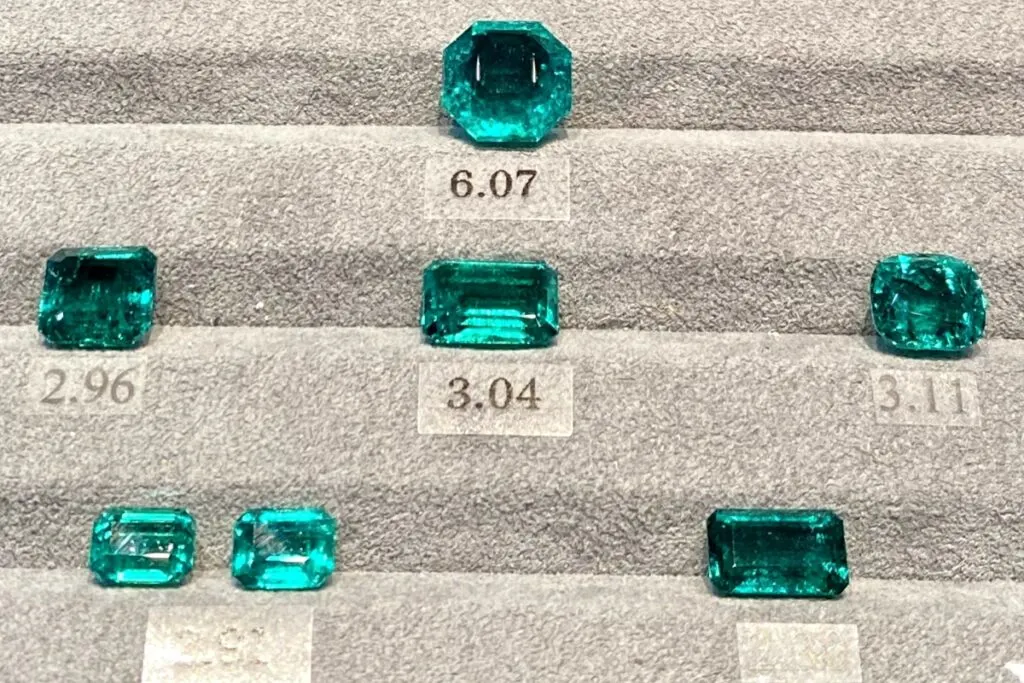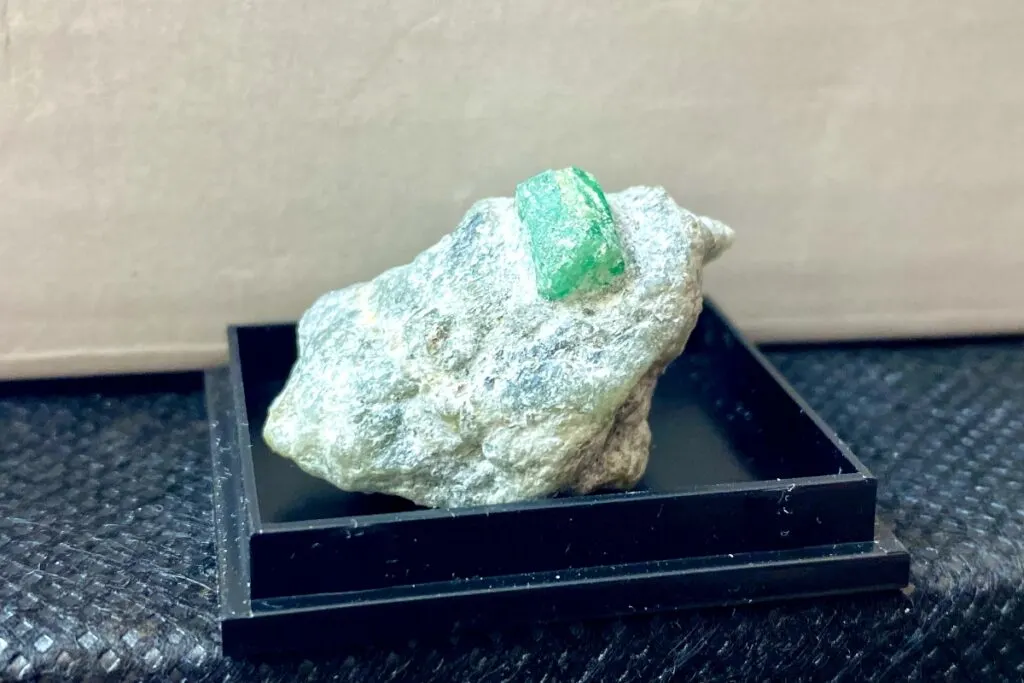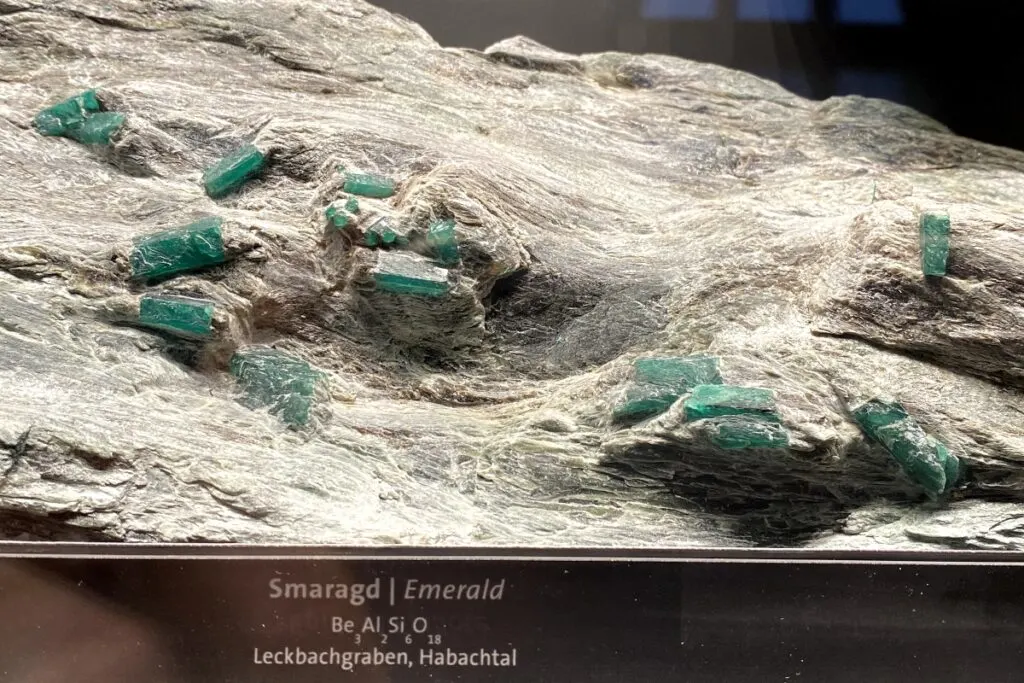As an Amazon Associate, I earn from qualifying purchases with no additional costs for you.
Emerald is one of the most well-known valuable gemstones; therefore, it is widely faked and substituted. Even more, being known for over 5000 years, it is probably the first gemstone faked with green-colored glass.
The main differences between real and fake emeralds are color, clarity, presence of specific inclusions (gas bubbles, metal flakes), growth patterns, type of fracture, form of crystal in a rough state, sharpness of facet junctions, and different reaction to touch test and the UV light test.
Emerald has numerous fakes represented by natural minerals and man-made imitations, as well as synthetics that have identical chemical compositions and many similar physical properties.
In the article, you will thoroughly describe emerald imitation, the most typical representatives of substituents and synthetic analogs, and how to differentiate real and fake emeralds based on their characteristic features.
However, we always recommend consulting with a professional gemologist for emerald nature identification, as some advanced equipment is needed to tell real and fake emeralds apart.

How to Tell if Emerald is Real
To tell if an emerald is real, focus on the inclusions, growth patterns, and sharpness of facet junctions. Real emerald has numerous inclusions because of specific geological formations. Real emeralds have no chevron growth patterns of synthetic emeralds. Facet junctions are sharp, without conchoidal chips.
Here is a brief list of real emeralds’ characteristics:
- The easiest way is to tell if an emerald is real to buy it in a rough crystal state. Rough crystals will preserve crystallographical characteristics like facets or facet junctions, revealing the signs of the paramount crystal form of a hexagonal prism (column).
- Pay attention to chips if available. Real emeralds don’t have conchoidal or shell-like surfaces of fracture.
- Attentive look to the emerald interior with magnifying glass or, better, a microscope (if you wonder where to get a microscope, jewelry stores usually have one and are ready to assist you with it). Check the emerald for the presence of bubbles or metal flakes.
BTW: Do you want to know more about rock and mineral identification? The books listed below are the best ones you can find on the internet (Amazon links):
- Smithsonian Handbooks: Rocks & Minerals
- Gemstone & Crystal Properties (Quick Study Home)
- Ultimate Explorer Field Guide: Rocks and Minerals (National Geographic Kids)
What Does Real Emerald Look Like

Real emeralds occur in blush-green to lush green and yellowish-green colors; they can be transparent to translucent, typically with numerous inclusions or fractures. Rough crystals occur in elongated hexagonal prism shapes. Faceted emeralds usually have octagon step cuts.
How to Test Emerald Stone at Home
Emerald is one of the most complicated stones for st home identification, especially if it is a faceted stone. It is impossible to test emeralds at home without at least a microscope.
Due to home testing, you can eliminate some guesses that emeralds can be faked by glass. However, spotting the difference in natural or lab origin of chemically similar material is almost impossible.
Therefore, we recommend taking our tips for an assumption. Only a qualified gemologist can give you a 100% answer.
The best home testing of emeralds is microscopic or loupe observation. Check the presence of gas bubbles or chevron-like structures to separate them from glass fakes and synthetic emeralds, respectively. Microscopic observation can reveal two or three-phase inclusions typical for real emeralds.
At home, testing strongly depends on what kind of emerald you will test, whether it is a rough crystal or faceted gemstone.
- Cleaning the material
The first step is constantly cleaning the material. Wash your stone with water and a soft cloth.
- Macroscopic observation
Observe rough crystal characteristics: note the color, clarity, and crystal form, and pay attention to the probable elongation of the crystal, the direction of fractures of any, and the type of fracture surface.
- The color of real emeralds should have no yellow and deep blue hues.
- Real emeralds in a rough state are never flawless. Clarity can be classified as translucent or semi-transparent. Use a flashlight to see the interaction with a light beam.
- Emeralds in perfect form are hexagonal prism. Note the angle between facets if you have a part of the crystal. Emerald has 60o and 90o angles.
- Fracture is usually uneven. No conchoidal or shell-like fractures should be seen.
For faceted stone, carefully observe a girdle (the part between the crown and pavilion of the stone; the widest part of the stone). Check if it differs somehow. In cases of fakes, it can be a glue that holds together parts of assembled stone.
- Microscopic observation
Take a magnifying glass or, better, a microscope. Also, use a powerful flashlight to light the interior of the stone. Check for the presence of
- Gas bubbles. They will point out the fake origin of the emerald.
- Metal inclusions. They are a sign of synthetic origin.
- Remember that real emeralds will always have some imperfections and tiny internal fractures.
TIP: Some minerals and rocks can easily be identified at home without complex equipment. Check out the complete guide in the article below:
Identifying Minerals and Rocks at Home (Step-by-Step Guide)
Do Emeralds Glow Under Black Light
Even though there are a lot of talks and articles about UV testing of emeralds, the actual situation is far more complicated.
Not all emeralds glow under UV light. Some emeralds from Muzo (Columbia) and Panjshir (Afghanistan) can have strong orangy-red to red luminescence. Some real emeralds from other deposits stay inert under the UV. Synthetic emeralds’ reaction also varies, but in most cases display vibrant red colors.
Fluorescence on emeralds (as well as the desirable green color) originates due to the presence of chromium in the mineral. The stones rich in chromium will glow in reddish hues under UV light.
While chromium enhances the fluorescence of emeralds, iron inhibits it. So various combinations of these two elements’ concentrations can give different luminescence effects.
Moreover, some emeralds’ valuable green color is created by the presence of vanadium. When the emerald’s deep green color is created by vanadium but not chromium, the reaction to the UV test will be inert.
UV test (blacklight test) can be helpful in the identification of emerald fracture-filling enhancement by various organic materials like various oils and epoxy resins of different origins. Fracture-filled emeralds will glow evenly chalky, marking the most significant filler concentrations.
That is why the Ultra Violet (UV) light or blacklight test on emeralds requires additional tests and a deep understanding of the crystal-chemistry process. So, relying on something other than the UV (blacklight) test is better.
BTW: If you are looking for the best UV light for rockhounding, find out my picks below (Amazon links):
- BEST OPTION: Convoy 8+ 365nm UV LED Flashlight with Patented Glass Filter
- BUDGET OPTION: Karrong Rechargeable 1200 Lumen 395nm UV Flashlight
- OPTION FOR INDOOR USAGE: Prime Upgraded Big Chip 396nm UV
How to Tell Fake Emerald

To tell fake emeralds, pay attention to inclusions and growth structures. Fake emeralds may have no inclusions or chevron-like growth structures, including gas bubbles or opaque metal inclusions. Fake emeralds can be warm to the touch, have conchoidal chips, or have rounded facet junctions.
Let’s start by determining fake types and dividing them into groups to simplify the understanding of the spotting fakes process. So fakes can be divided into imitations – any material that looks like a natural emerald (natural green gemstones or man-made materials) and synthetic emeralds grown in the labs.
Some real minerals that can imitate emeralds are dyed quartz, fuchsite quartzite, sillimanite, dyed or/and assembled beryl, green tourmaline (verdelite), diopside, serpentinite, or low-quality jade to imitate low-quality emeralds.
Man-made emerald imitations are represented by synthetic spinel, synthetic cubic zirconia, synthetic yttrium aluminum garnet (YAG), and even simply glass.
Today’s synthetic emeralds are identical in appearance and physical properties to real natural emeralds. Only gemological labs can tell the synthetic origin of emeralds using advanced scientific methods.
Important note!
Having emeralds in old estate jewelry doesn’t mean the emerald is of natural origin. Lab-grown emeralds were widespread during the previous century.
Helpful tip!
Here is an excellent hint for detecting synthetic emeralds in jewelry. If emeralds set in jewelry are perfectly matched by color and clarity, they are likely synthetic.
TIP: Emerald is on the top of the most valuable gemstones. Prices for emerald ranges dramatically depending on color, clarity, and weight. Find out more in the article below:
Emerald Value: Main Factors & Prices for Different Units
How to tell if Emerald is Lab-Created
Lab-created or synthetic emerald is a laboratory-grown material with essentially the same chemical composition, crystal structure, and properties as a natural emerald. Many synthetic emerald manufacturers supply synthetic emeralds on the market.
To tell if an emerald is lab-created, check the presence of chevron-type growth patterns, metal inclusions, and gas bubbles. Generally, lab-created emeralds have higher clarity and look absolutely flawless at first glance. Also, synthetic emeralds can display a vibrant red glow under the UV.
Synthetic emeralds are known from the 1930s. Hydrothermal growth methods primarily produce them. The crystal size depends on the growth time. It can take weeks to months to produce a crystal.
There are several leading synthetic emeralds manufacturers: Chatham Created Gems, Kyocera International/Inamori, Gilson/Nakazumi, Malosi, Linde-Regency, Tairus, Biron, or Kimberley, and Zerfass and Jaeger, which are definitely accompanied by less-known producers.
Important tip!
If you see an emerald called Chatham emerald, Kyocera emerald, and so on, be informed that these are the names of the lab where synthetic was grown but not a deposit the natural emerald originates from, like Muzo, Chivor, or Kagem.
To identify lab-created emeralds, it’s necessary to consult with a professional gemologist as a sophisticated appliance is needed.
Distinguishing features between real and lab-created emerald lie in differences in microscopically growth patterns, types of inclusions, and mainly in trace elements composition.
The main elements (Si, Be, Al, O) are identical; the difference hides in trace elements like Mo, W, Pt, and Y, which are atypical for natural emeralds.
Can Emerald be Faked
Emeralds are severely faked. The history of faking emeralds can be traced to ancient Egypt, where glass beads faked emeralds. Emeralds are faked both in faceted gems and in a rough crystal state. Other minerals, glass, numerous synthetic materials, and lab-grown emeralds can fake them.
Emeralds have one of the most extended histories of faking. Some people believe that buying rough crystals save from fakes.
Unfortunately, there are reported examples of fake rough emeralds composed of assembled quarts and pale green beryl debris glued together with mica with a metal plate inserted to increase the weight of the rough sample.
Another example was faked trapiche emerald, assembled from Cr-bearing mica and some artificial dark material.
The presence of chemically identical synthetic emeralds makes emerald identification extraordinarily complicated and requires advanced X-ray and spectroscopic methods, like Infrared and micro-Raman spectroscopy.
TIP: Learn more about advanced mineralogical and gemological methods in the detailed article:
Modern Methods of Rock & Mineral Identification (by Expert)
Difference Between Real and Fake Emeralds

The main differences between real and fake emeralds are color, transparency, form of the crystal, types of inclusions present (gas bubbles, metal inclusions, and growth patterns), types of fractures, sharpness of facet junctions, and reaction to UV light and warmth to the touch.
The table can give hints to spot disagreements of physical properties with real emeralds. The table can be used for preliminary assumptions about whether the observed emerald is real or fake.
Only further study with sophisticated gemological methods and consultation with a professional gemologist can identify the nature of the emerald sample.
| Characteristic property | Real emerald | Fake emerald |
|---|---|---|
| Color | It commonly has numerous inclusions and fractures. | Light-green, yellowish-green. |
| Clarity | Translucent to transparent. | Either perfectly transparent or, vice versa, opaque. |
| The presence of inclusions | Commonly has numerous inclusions and fractures. | It commonly has numerous inclusions and fractures. |
| The form of raw chrystals | Elongated hexagonal prism. | Any other non-hexagonal shapes. |
| Type of fracture | Uneven. | Conchoidal or shell-like fracture in the case of glass fakes or quartz imitations. |
| The presence of gas bubbles | None. | It can be present in glass fakes and synthetic emeralds. |
| The presence of opaque metal inclusions | None. | It can be present in synthetic emeralds. |
| Growth patterns | Sometimes oscillatory zoning is present. | Foiled, chevron-like growth patterns. |
| Touch test | Cold to the touch. | Some fakes can be warm to the touch. |
| The facet junctions | Sharp. | Rounded facet junctions. |
| The UV light test | From inert to orangy-red. | Cr-doped synthetic emeralds glow vibrant red under the UV. |
TIP: To find emeralds in nature, you must look for them in gravels, mines, pegmatites, or creeks. Find out the complete guide on finding emeralds in the United States in the article below:
Where to Find Emerald: Best Environments & Locations (USA)
Conclusion
Numerous emerald fakes were created during the thousands of years of emerald history. Emerald fakes are represented by imitations like other natural stones (green, beryl, quartz, sillimanite, tourmaline, diopside) or by man-made materials (synthetic spinel, YAG-yttrium aluminum garnet, cubic zirconia) and simply glass and ceramics.
Moreover, people can use assembled stones from different materials to substitute faceted and rough emeralds.
The next level of emerald fakes is synthetic or lab-grown emeralds that are identical to natural emeralds physically and chemically. Lab-grown emeralds are acceptable for the industry, making emeralds affordable for everyone until they are sold like natural emeralds.
Distinguishing between natural and fake emeralds is highly complicated and should be held by a professional gemologist in a gem lab.
Here we list properties that allow us to assume whether the stone is natural emerald or fake.
- Color. Strongly yellowish or bluish hues are a signal of fakes.
- Clarity. Perfectly transparent stones are indicators of possible fakes.
- The presence of inclusions. The lack of inclusions is a fake indicator.
- The form of raw crystals. A hexagonal prism is a typical form of a real emerald.
- Type of fracture. Conchoidal or shell-like fracture surfaces are indexes of fakes.
- The presence of gas bubbles. Gas bubbles are atypical for real emeralds.
- The presence of opaque metal inclusions. Metal inclusions are a sign of synthetic origin.
- Growth patterns. Chevron-like growth patterns are typical for synthetic emeralds.
- Touch test. Warmth to the touch is a fake sign.
- The facet junctions. Round facet junctions are also fake indicators.
- The UV light test. UV light test is tricky! Vibrant red glow under UV, in most cases, signals fakes (exclusions are emeralds from Muzo (Columbia) and Panjshir (Afghanistan) deposits.
TIP: Beryl and emerald have the same chemical formula. Both chemically and structurally, they are the same material. Check out their differences in the article below:
Beryl vs. Emerald: 7 Key Differences (Are They The Same?)
